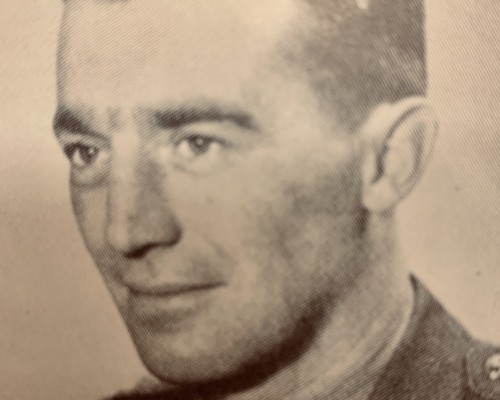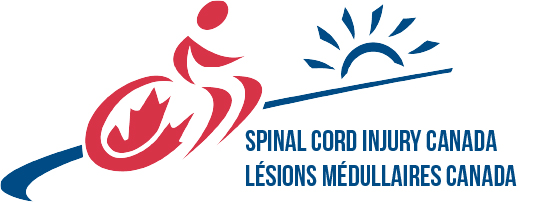John Counsell

The following story is historical fiction, based on research from many different sources. Thank you to all of those who documented Spinal Cord Injury Canada's history.
The waves splash hard against the boat as it approaches land. My heart is pounding, and so is my head. I’m not sure if it is the rocking of the deck or the adrenalin rushing through my veins that is tightening my stomach. I feel sick, but I am alert. I am ready to go.
I hear a loud command to charge the shore, and I jump into waist-high water. Almost at the sound of the splash, other soldiers begin to fall down around me.
The screams.
The blood.
It is a summer day in August,1942. I have landed in Dieppe.
I make it to the shore. It is different from the beaches we trained on in England. The ground is made up of shale, not pebbles, and because the shale moves sideways underfoot, it is easy to stumble. I wonder where the ship with the tanks is. Why is there no artillery support for us? The tanks arrive 20 minutes late, slowed down by the tide. There are 29 tanks on the boat. As they come off the stern, I watch two drop into the deep water. I run toward the boat and start to place wood down, to help guide the tanks up the beach.
I turn to call to my men. Then the screams and blood come from me.
A bullet hits me in the back. Even though I can’t move my legs, I can feel the early morning sunshine on my face. I think of my darling wife, Maida. Soldiers keep dropping all around me. The waves lap against their bodies, trying to wake them from this never-ending, bloody nightmare.
I lie so very still. Too still. But I don’t really notice because I am irritated by the grit in my eyes. I never pass out, perhaps because it is so loud. I watch the horror around me. At some point, and I can’t say how long later, another soldier from my troop, the Royal Hamilton Light Infantry, drags me back to a boat that has arrived. I try to help lighten his load, but I can’t get my feet under my body. Shots and mortar are landing all around us. Amazingly, we make it onto the last ship heading back to England. But the vessel has waited too long for us last stragglers. The tide is going out, and now the hull is stuck in the sand. A few men jump back out into the water to dislodge it, and fewer men get back in. We leave without them. I honestly don’t remember the voyage through the English Channel. Less than 50% of us from this battle make it back to England.
I open my eyes, and I am in a hospital bed. There is an odd smell that I can’t identify. Tubes are everywhere. I am at No 1 Neurological Hospital in Basingstoke. A Canadian doctor named Harry Botterell is attending to me. In fact, this is a Canadian military hospital in England. He tells me I am the first Canadian soldier he has seen with a spinal cord injury, and that it will take a while for me to heal and get strong enough to make it home.
It turns out that Dr. Botterell is quite good at what he does. He uses new medical techniques and medicines to keep me alive. Comparatively, in WWI 80 % of the soldiers who had a spinal cord injury didn’t survive.
During my time at Basingstoke, I begin to learn how to look after myself. In our bed-side chats, Dr. Botterell tells me that he’s worried about what will happen to people like me back in Canada. There are no rehabilitation services for people with paraplegia. He thinks I should go home and unite others with spinal cord injuries to lobby the government and get the support we need. I’m not so sure. I think I would like to stay here a while and get stronger. However, sooner than expected, the approval comes for me to board the ship Lady Nelson to return to Canada. When we land, I travel by hospital train to the Montreal Neurological Institute.
I have several spinal surgeries here under the lead neurosurgeon, Dr. William Cone. Afterwards, I think about my future life. Sometimes, I wonder why I was saved. Some of the other men at the Institute don’t say a word, while others won’t stop talking. I am losing myself. I can’t spend the rest of my life stuck in bed with others in such despair all around me, but I don’t know what to do. I am re-learning how to care for myself. I have pretty much figured out my routines. But I’m bored... and sad. I think it would be best if I moved closer to my family in Toronto.
This morning I’m in bed, again. There are only a few wheelchairs here, and I didn’t get up early enough to grab one. The chairs are hard to move, and the wicker is incredibly uncomfortable, but I also don’t want to get a bedsore. Dr. Botterell taught me that I need to get up to look after my skin and build up my strength. Dr. Cone also talked about the importance of getting up out of bed. He tells me about a folding wheelchair from a company in the United States. He says I should try to get one.
Despite the dirty window high on one wall of the hospital ward, I can see that it is a nice day. I wish they would open it so I can smell the fresh air. But maybe they know the sweet wind would dance all of our minds back to a time when we sidestepped our woes and breezed easily through our days.
I notice there’s a new gentleman on the ward wheeling around from patient to patient. Dr. Cone has asked him in to visit us. When he gets to me, we introduce ourselves. He is Jimmy Darou. Jimmy also has a spinal cord injury. His first words to me are, “what the hell are you doing lying about and feeling sorry for yourself?” I’m a little taken aback, but I must say that seeing how confident he is makes me believe I can take control of my destiny, too! Jimmy gave me hope that day.
Jimmy had been a jockey until his horse fell on him during a race. Now, he pumps gas from his own gas station in downtown Montreal. Seeing what he can do gives me the courage to try and bring some purpose to my life. Jimmy comes in regularly to chat. It is simply fantastic to have a peer who understands what I am going through. I now know there is so much more I can do in my life. We are fast friends, and we often go to the race track together.
I move to Toronto, but my wife Maida does not come. Our marriage ends. I initially stay with my sister, Elizabeth, and her husband, Walter Gordon. From talking with Jimmy, I know I have to follow his exercise routine to get stronger. I work on my upper body strength every day. I also have to organize a few things to make my life more comfortable.
Eventually, I move back to my hometown of Hamilton for a year, but work brings me back to Toronto. I get a suite at the Park Plaza Hotel. I am lucky because I can afford private nursing care. I also have family friends who can help me. One of my pals, John McCarthy, is the son of the Canadian Ambassador to the United States. John helps me get one of those folding wheelchairs Dr. Cone talked about from a Californian company called Everest & Jennings. I have also ordered hand controls so I can drive my car. With my folding chair and my car, I now have the freedom to go where I want, and when I want, for the first time in almost two years. In Jimmy’s honour, I go to the race track and buy my own horse. I name him Early Mischief!
I think back to what Dr. Botterell had said. I was one of the first veterans to come home. Now, there will be others like me with spinal cord injuries. I need to share with them all the tips and tricks that Jimmy shared with me. And we all need to talk. We need to organize. If we don’t plan our future, no one else will.
I visit the veterans at Christie Street Military Hospital. It is a dump. Nearby trains pass by so frequently, and they shake the whole building. They are so close, you can smell them in the hospital’s hallways, and the beds are covered in grime. I regularly visit because I want to keep the men’s spirits up. I want them to know that their time at Christie Street Military Hospital is not what the rest of their lives will look like. We talk about our future. Together, we build hope.
And who comes back to Canada to be the Chief Neurosurgeon at Christie Street Military Hospital? None other than Dr. Botterell. I know he’s an ally. He supports us in building our future.
I am fed up with not knowing when my pension and benefits will come, or how much they will be. It’s hard to get answers from government workers. I, with veteran organizations, lobby the Federal Government, which creates the Department of Veterans' Affairs. Soon after, I push the Department to provide essential aids, like the folding wheelchair I have, to help people be independent. I also want to create a rehabilitation centre for people with spinal cord injuries. I continue to advocate.
On New Year’s Day, 1945, thanks to support from the Department of Veterans' Affairs, we spend $45,000 on the house that will become Lyndhurst Lodge. It is a big home in Toronto on three acres of land. It has a gym, tennis court, movie theatre, and a bowling alley. We hire Dr. Albin Jousse to work with Dr. Botterell and to teach self-help techniques. I also hire nurses, orderlies, cooks, and maids. Lyndhurst Lodge is the first rehabilitation facility in the world, specifically for people with spinal cord injuries. I drive up to the Lodge, and pull out my chair. I roll through the halls, waving hello. Then, I get back in my car and tell them all I am off to the races. They see that life can be grand!
On January 16, 1945, seven of us decide to form the Canadian Paraplegic Association. You now know our organization as Spinal Cord Injury Canada. On May 10, 1945, we incorporate. I am the organization’s first president and managing director. By 1950, people with spinal cord injuries across the country are united. Our work focuses on rehabilitation and independence. We work with the Department of Veterans' Affairs to get mobility aids and veterans’ pensions and benefits. We also ensure that civilians will get mobility aids, too. We help people get jobs and work towards improving access to places and spaces. My life’s work is tied to this organization.
For my war efforts, I receive the Military Cross for bravery and the Order of the British Empire. For my effort in uniting Canadians with spinal cord injuries, I become a member of the Order of Canada in 1967 and an Officer of the Order of Canada in 1972.
I die with pride in 1976, hopeful that the men and women who follow after me in this organization continue to fight for the rights and freedom of people with spinal cord injuries.
Read another story about John Counsell: Societate Fortiores.
